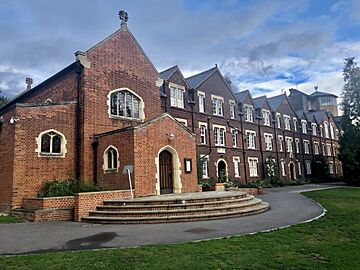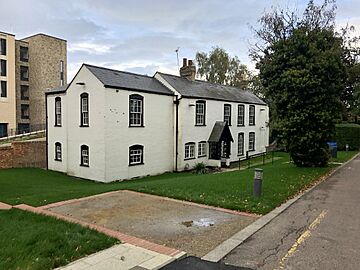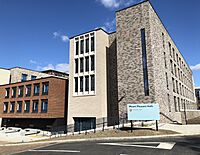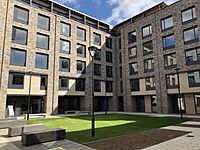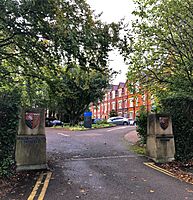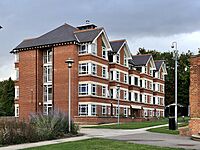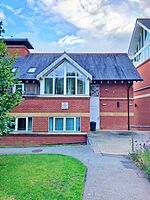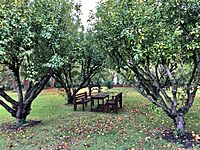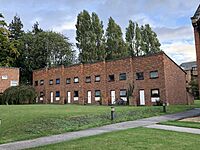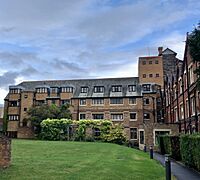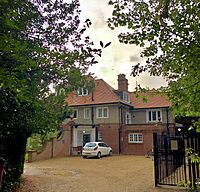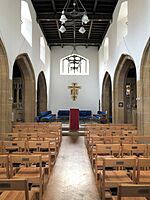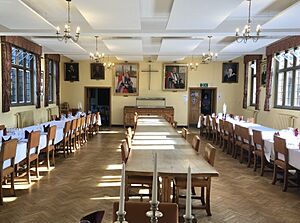St Edmund's College, Cambridge facts for kids
Quick facts for kids St Edmund's College |
||||||||||||||||||
|---|---|---|---|---|---|---|---|---|---|---|---|---|---|---|---|---|---|---|
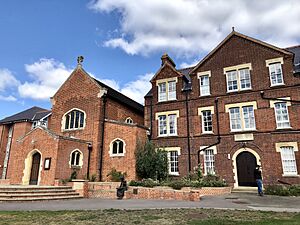
St Edmund's College Chapel and the original Norfolk Building
|
||||||||||||||||||
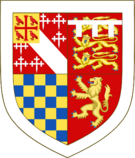
Arms of St Edmund's College
Blazon: Arms of Henry Fitzalan-Howard, 15th Duke of Norfolk (quarterly of four: Howard, Brotherton, Warenne, FitzAlan) with a canton of St Edmund of Abingdon (Or, a cross fleury gules between four Cornish choughs proper) all within a bordure argent |
||||||||||||||||||
|
|
||||||||||||||||||
| University | University of Cambridge | |||||||||||||||||
| Location | Mount Pleasant, Cambridge (map) | |||||||||||||||||
| Full name | The Master, Fellows and Scholars of St Edmund’s College in the University of Cambridge | |||||||||||||||||
| Latin name | Collegium Sancti Edmundi | |||||||||||||||||
| Abbreviation | ED | |||||||||||||||||
| Motto | Per Revelationem et Rationem (Latin) | |||||||||||||||||
| Founders |
|
|||||||||||||||||
| Established | 1896 | |||||||||||||||||
| Named after | Edmund of Abingdon | |||||||||||||||||
| Previous names | St Edmund's House | |||||||||||||||||
| Age restriction | 21 and older | |||||||||||||||||
| Sister college | Green Templeton College, Oxford | |||||||||||||||||
| Master | Catherine Arnold | |||||||||||||||||
| Undergraduates | 188 (2022-23) | |||||||||||||||||
| Postgraduates | 528 (2022-23) | |||||||||||||||||
| Map | ||||||||||||||||||
| Lua error in Module:Location_map at line 420: attempt to index field 'wikibase' (a nil value). | ||||||||||||||||||
St Edmund's College is a college that is part of the famous University of Cambridge in England. It was started in 1896. It's one of the oldest colleges in Cambridge that focuses on older students. This means it mainly accepts students who are studying for advanced degrees (like Master's or PhDs) or undergraduate students who are 21 years old or older.
The college is named after St Edmund of Abingdon (1175–1240). He was a very important person, known as the first Oxford Master of Arts. He also became the Archbishop of Canterbury from 1234 to 1240. The college has strong ties to the Catholic Church. Its founders were Henry Fitzalan-Howard, 15th Duke of Norfolk and Baron Anatole von Hügel. Baron von Hügel was the first Catholic to get a degree from Cambridge since 1688! The main religious leader who visits the college is the Archbishop of Westminster.
St Edmund's College is located on Mount Pleasant, which is northwest of the main part of Cambridge. It's close to other colleges like Lucy Cavendish College and Fitzwilliam College. The college campus has beautiful gardens. It sits on the edge of what used to be Roman Cambridge. There's enough housing for over 350 students.
Many interesting people have been part of St Edmund's College. These include Georges Lemaître, a scientist who helped develop the Big Bang theory. Also, several Olympic medalists like Simon Schürch (Gold) and Thorsten Streppelhoff (Silver) have studied here. St Edmund's was important because it was the first place for Catholic students at the university in 200 years. This happened after a ban on Catholics attending Oxford and Cambridge was lifted in 1895.
Contents
College History
How St Edmund's Began
St Edmund's House, as it was first called, was founded in 1896. Henry Fitzalan-Howard, 15th Duke of Norfolk and Baron Anatole von Hügel created it. Their goal was to provide a place for Roman Catholic students to live and study at the University of Cambridge.
For a long time, Catholic students were not allowed to attend Oxford and Cambridge universities. This changed in 1871. However, the Catholic Church still worried about students attending these universities. In 1895, the Pope lifted the ban. This was thanks to people like Anatole von Hügel. There were some conditions, like having a Catholic chaplain and a library with Catholic books. The Duke of Norfolk bought land in Cambridge. This led to the Cambridge University Catholic Chaplaincy being set up at St Edmund's House in 1886.
In its early days, the college was mostly a place for students to live. These students were officially part of other Cambridge colleges. Many of them were Catholic priests studying different subjects. The college took over the buildings of Ayerst Hostel, which had closed down. The first head of St Edmund's House was Edmund Nolan.
Becoming a Full College
For many years, people tried to make St Edmund's House a full college of the University of Cambridge. But this was difficult because of religious differences at the time. Also, the university worried that the college was not fully independent. Its money was managed by the Catholic Church.
The college's chapel was officially opened in 1916. A new dining hall was built in 1939. More and more students joined, and it became a recognized "House of Residence." This meant it was part of the university but not yet a full college.
In the 1960s, more students wanted to do advanced studies. So, the university created new colleges mainly for these students. St Edmund's House became one of these new colleges. This helped it gain more recognition. In 1965, the college was allowed to accept its own students. It also started electing its own academic staff, called Fellows.
In 1986, the college's money and property were transferred from the Catholic Church to its own governing body. This made it fully independent. At this point, its name changed from "St Edmund's House" to "St Edmund's College." In 1996, it finally became a full college of the university. This was confirmed by a special document from the King in 1998. Today, St Edmund's welcomes students of all faiths and backgrounds.
Buildings and Grounds
Norfolk Building
The Norfolk Building is the oldest structure on the college site. It dates back to 1896. It used to be the Ayerst Hostel. This building provided living space for the first Master of St Edmund's and its first four students. It has a classic Gothic revival style. The building has been expanded over the years. Now, it holds important areas like the student common room, dining hall, and kitchens.
Chapel
The college chapel is a special building. It was designed by Benedict Williamson. It was officially opened in 1916. The chapel is known for its simple and Gothic Revival architecture. While it has Catholic roots, it is open to people of all Christian faiths. In 2003, a beautiful stained-glass window was added. It shows Saint Boniface, who was important in spreading Christianity in Germany.
Outside the chapel, there is a bronze statue of the college's patron, St Edmund of Abingdon. He is shown holding a Bible. This statue was created by Rodney Munday, a former student. It was placed there in 2007. The chapel also has a choir that performs concerts.
College Expansion
St Edmund's College continues to grow. In 2000, a new building for 50 students was opened. It was named after Richard Laws, a former Master of the college. In 2006, two more residential buildings were added. These provide rooms for 70 students and apartments for couples. They are named after Sir Brian Heap and Geoffrey Cook, who were also important leaders at the college.
In 2016, big plans were announced for new buildings and two new courtyards. These new buildings will have a modern design. However, they will still use traditional materials like brick. This will help them fit in with the older parts of the college. A new student center is also planned. The city council approved these plans in 2017.
Okinaga Tower
The Okinaga Tower was built in 1993. It was made possible by a gift from the Teikyo Foundation. It is the tallest building at the college. The tower was designed by Roderick Gradidge. It contains the Master's Lodge, which is where the head of the college lives. It also has a special suite with great views of the city. Betty Boothroyd, who was the Speaker of the House of Commons, opened the tower.
Courts and Other Buildings
Old Court was built in the early 2000s. It is located west of the Norfolk Building. It is surrounded by newer buildings like the Brian Heap Building and the Library Building. Most of these buildings are student dormitories. They were built to house the increasing number of students.
New Court was finished in 2019. It also provides student housing. It includes the Mount Pleasant Halls. This area gives St Edmund's College a front view onto Huntington Road.
The College Sporting Grounds are west of the Richard Laws Building. Students can play soccer and other outdoor games here.
The College Orchard is south of the Sporting Grounds. It has large grassy areas with apple trees. There are also outdoor seats and a barbecue area for students to enjoy.
White Cottage is an old farmhouse from the 1700s. It is painted white and looks quite different from the newer college buildings. It was the first home of the Von Hugel Institute. This institute studies Christianity and society. It was created in 1987 to keep the college's Catholic history alive.
Bene't House is another old house. It is southeast of the Norfolk Old Wing. It is named after St Benedict of Nursia. Since 2018, it has been home to the offices of the Von Hugel Institute.
Gallery
Academic Life
St Edmund's is known for being a very international college. In 2018-2019, students came from over 80 different countries. Students at the college study a wide range of subjects. These include arts, humanities, social sciences, natural sciences, medicine, and veterinary medicine. The college's academic staff, called Fellows, also specialize in many different areas.
The college has a research center called the Von Hügel Institute. It was founded in 1987. This institute studies Catholic Social Teaching. It aims to explore how Christianity relates to society. It also helps to keep the college's Roman Catholic history alive.
The college's undergraduate exam results are usually in the middle range compared to other Cambridge colleges. In 2018, it ranked 21st on the Tompkins Table, which compares academic performance.
Student Life
St Edmund's College is newer than some of the very old Cambridge colleges. However, it still follows many old Cambridge traditions. One of these is "formal hall." This is a special dinner where students and Fellows eat together. Unlike some other colleges, St Edmund's does not have a separate "high table" for Fellows. This means everyone can mix and talk during dinner. Students are still expected to wear their academic gowns for formal dinners and other special events. The St Edmund's gown is black with unique details around the neck and sleeves.
The college has a strong tradition in sports. It has a boat club, a hockey club, and a cricket club. The hockey club won the 2024 Cuppers competition. The cricket club reached the finals in 2023. In recent years, students from St Edmund's have also played for the university's main teams. They compete against Oxford University in big events like The Boat Race and The Varsity Match.
In 2017, a team of four rowers from the college broke a world record. They rowed continuously for over an hour longer than the previous record. The next year, in 2018, a team of ten rowers set a British and World record. They rowed one million meters on an indoor rowing machine.
People Connected to the College
- Further information: Category:Alumni of St Edmund's College, Cambridge, Category:Fellows of St Edmund's College, Cambridge, and Category:Masters of St Edmund's College, Cambridge
Many notable people have been part of St Edmund's College. Here are a few examples:
-
Mary McAleese, who used to be the President of Ireland.
-
Martin Evans, a biologist who won the Nobel Prize in Physiology or Medicine.
-
Joaquín Almunia, a Spanish politician who was a European Commissioner.
Famous Alumni
- Joaquín Almunia, a Spanish politician.
- Simon Amor, a rugby union coach.
- Mary McAleese, former President of Ireland.
- Eamon Martin, the Archbishop of Armagh.
- Norman St John-Stevas, Baron St John of Fawsley, a legal scholar and politician.
- Thorsten Streppelhoff, an Olympic Silver medalist in rowing.
- Marc Weber, an Olympic Silver medalist in rowing.
- Stuart Welch, an Olympic Silver medalist in rowing.
Notable Fellows
- Sir Martin Evans, a biologist and Nobel Prize winner.
- Sir Brian Heap, a biologist and former Master of the college.
- Georges Lemaître, the cosmologist who developed the Big Bang theory.
Masters of St Edmund's College
St Edmund's House
- 1897–1904: William Ormond Sutcliffe
- 1904–1909: Edmund Nolan
- 1909–1918: Thomas Leighton Williams
- 1918–1921: Joseph Louis Whitfield
- 1921–1929: John Francis McNulty
- 1929–1934: Cuthbert Leonard Waring
- 1934–1946: John Edward Petit
- 1946–1964: Raymond Corboy
- 1964–1976: Garrett Daniel Sweeney
- 1976–1985: John Coventry
- 1985–1996: Richard Laws
St Edmund's College
- 1996–2004: Brian Heap
- 2004–2014: Paul Luzio
- 2014–2019: Matthew Bullock
- 2019–present: Catherine Arnold
See also
- Listed buildings in Cambridge (west)


